#the nile mosaic of palestrina
Explore tagged Tumblr posts
Text
Greco-Egyptian art and culture in Italy: the Nile Mosaic of Palestrina
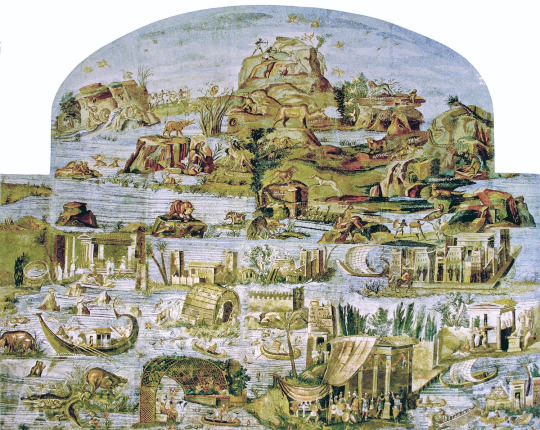
“AMONG ITS EXTRAORDINARY COLLECTION OF regional archaeology, the National Archeological Museum in Palestrina preserves a magnificent piece that stands apart from the rest: an ancient mosaic depicting a vivid scene of the flooding river Nile.
Dating to the 1st century BCE, this Egyptian mosaic is believed to be the product of Alexandrian craftsmen, and it is among the most spectacular of the late Hellenistic age. Measuring almost 20 by 13 feet (6 by 4 meters), the mosaic depicts a flooded Nilotic landscape, inhabited by animals both real and imaginary, Ptolemaic Greeks, Aethiopian hunters, and priests performing rituals in their magnificent temples. The figures are often labeled in Greek characters and the entire scene may represent a vivid map of the Nile as it flows from the highlands of Ethiopia to the delta in the Mediterranean Sea.
Archaeologists expect the mosaic was originally used as a flooring decoration for an apse in a large rectangular room built as an artificial grotto (as can be surmised from the shape of the mosaic), by the forum of the city of Praeneste. The piece has also been identified as evidence of the early spread of Egyptian cults in Italy, especially the cult of the Goddess Isis. (Certain scholars claim that Isis was already at this point being identified with Fortuna, Goddess of Praeneste.)
The mosaic’s rediscovery and preservation have been tumultuous: In the 1600s, the Barberini family removed the mosaic and took it to Rome. It was then returned to Palestrina but damaged in the process and had to be restored anew. During the Second World War, to avoid damage from the allied bombings, the mosaic was once more removed, but it is now again on display in Palestrina.
Know Before You Go
The Nile mosaic is on display on the third floor of the museum, which is open every day from 9 a.m. to 8 p.m.”
Source of the text: https://www.atlasobscura.com/places/nile-mosaic-of-palestrina
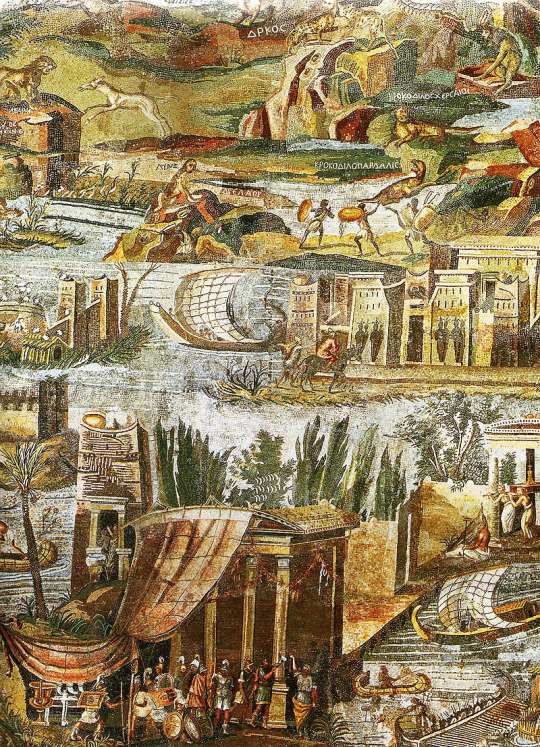

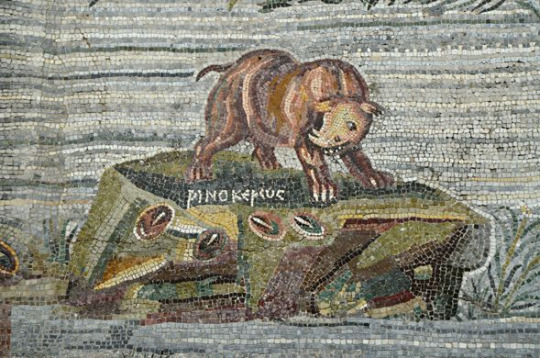
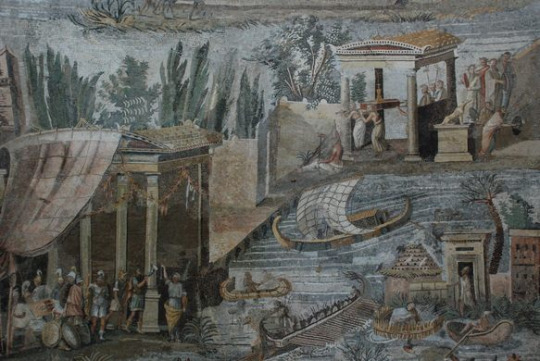


23 notes
·
View notes
Text

The Finding of Moses
Artist: Nicolas Poussin (1594–1665)
Title: Moses Saved from the River
Genre: Religious Art
Date: 1630
Medium; Oil on Canvas
The Finding of Moses
Description
When the Pharaoh ordered the killing of all boys born to the Israelites, Moses was hidden by his mother in a basket of bulrushes on the river Nile. There he was discovered and adopted by the Pharaoh's daughter. In Christian theology Moses was considered a precursor of Christ and analogies were drawn between his escape and Jesús's flight into Egypt. The palace in the background is based upon one in a Roman mosaic at Palestrina, excavated a few years previously. To the right is a personification of the River Nile. The joyfulness of this event is expressed through the bright colours of the fluttering drapery and the gestures of the figures. This painting was commissioned by Reynon, a silk merchant of Lyon and subsequently belonged to Clive of India (1725–1774), from whom it was inherited by the Earls of Powis.
Exodus 5-6
Then Pharaoh’s daughter went down to the Nile to bathe, and her attendants were walking along the riverbank. She saw the basket among the reeds and sent her female slave to get it. She opened it and saw the baby. He was crying, and she felt sorry for him. “This is one of the Hebrew babies,” she said.
#religious art#nicolas poussin#17th century art#moses#river nile#pharaoh's daughter#egypt#joyfulness#old testament#landscape#bridge#river#trees#egyptian#book of exodus#christian art#christianity
3 notes
·
View notes
Text
For #TilesOnTuesday + a belated #SaveTheRhinoDay:
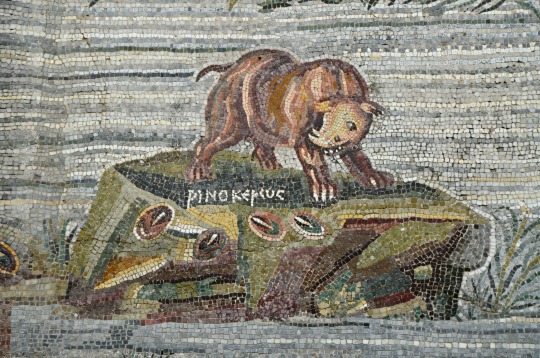
“A two-horned African rhinoceros ‘PINOKEPOC’ on the Nilotic mosaic of the flooding of the river Nile in Egypt, from the Sanctuary of Fortuna Primigenia at Praeneste, c. 100 BCE, Palestrina Museo Archeologico.”
#Tiles on Tuesday#Save the Rhino Day#animal holiday#ancient art#Nilotic scene#mosaic#rhino#rhinoceros#African wildlife#African animals#animals in art#ancient Egypt#ancient Roman art
31 notes
·
View notes
Photo




Nile Mosaic at Palestrina, Italy, dated to 1st century BCE.
https://www.atlasobscura.com/places/nile-mosaic-of-palestrina
#rome#egypt#ancient egypt#ancient rome#mosaic#ancient art#nile#roman#greek#greek art#palestrina#italy#praeneste
377 notes
·
View notes
Photo

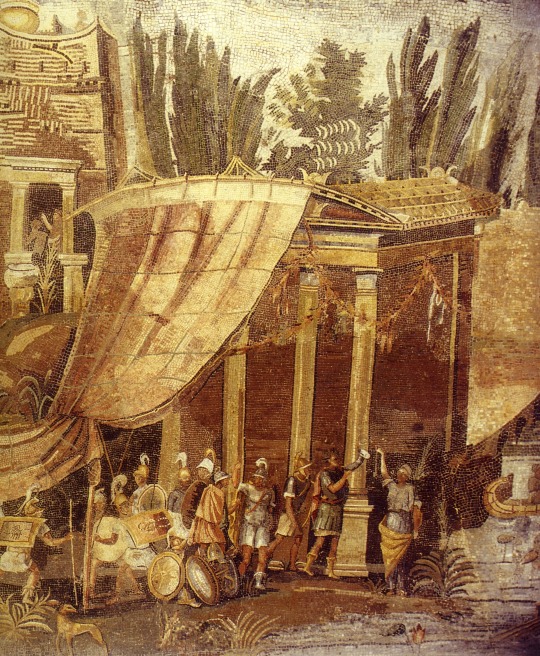


#nile mosaic#palestrina mosaic#praeneste#sulla#republican rome#ancient rome#1st century bc#2nd century bc#nilotic scene#my post#tagamemnon
152 notes
·
View notes
Photo

Detail of a rhinoceros (PINOKEPOC) from the Nile Mosaic of Palestrina. This mosaic has an interesting history: thought to be created for an artificial grotto by Alexandrian craftsmen, it is identified as evidence of the spread of Egyptian cults in Italy (eg. the cult of Isis). Late Hellenistic - 1st century BC.
89 notes
·
View notes
Text
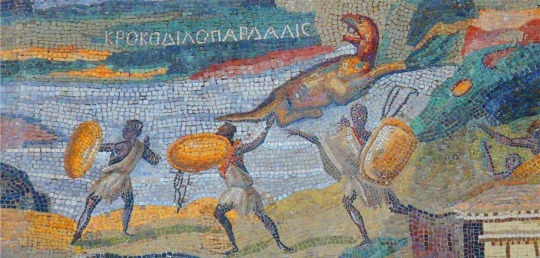
A evolução é um mito: Mosaico do Nilo de Palestrina retrata homens caçando um animal pré-histórico extinto há milhões de anos
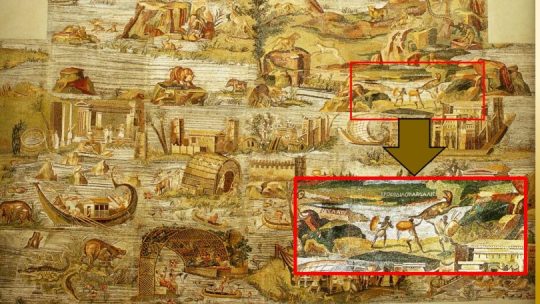
A arte de mosaico chamada “O Nilo de Palestrina”, datado de 100 a.C., representa o Nilo em sua passagem do Nilo Azul para o Mediterrâneo e retrata a vida cotidiana em uma cidade a leste de Roma. Nele encontram-se retratados muitos animais familiares com legendas em grego, incluindo o crocodilo, o macaco e a tartaruga.
Mas o que mais chama a atenção nesse piso helenístico tardio, é a áreas do mosaico que ilustra homens caçando uma criatura parecida com um dinossauro em um lago. A identificação do animal exibido no close-up está sujeita a muita controvérsia, visto que é difícil identificar com qualquer grau de exatidão a criatura. Cristãos conservadores e defensores do criacionismo, para corroborar suas crenças e teorias, têm invariavelmente apontado o animal representado nesse mosaico como sendo indubitavelmente um dinossauro.
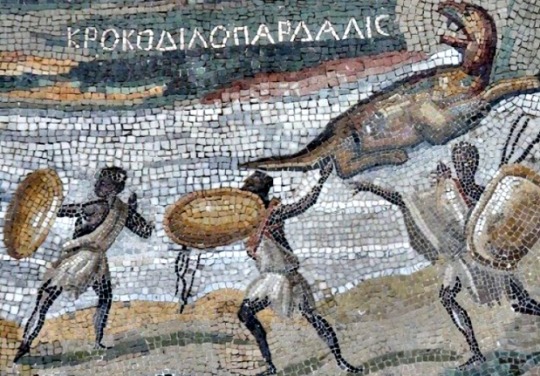
Foi sugerido que o animal pode ser uma lontra, mas este não é caso, porque em outra parte do mesmo mosaico está exposta uma imagem de um par de animais que é explicitamente legendada como lontras.
A legenda grega para este animal diz que ele é um “crocodilo-leopardo”, um animal inexistente na galeria de nossa zoologia ou paleontologia. A antiga palavra para “girafa” era “camelo-leopardo” em referência à morfologia semelhante a de um camelo e ao padrão de cores semelhantes de um leopardo. Por que o animal do mosaico seria chamado de “crocodilo-leopardo”? A parte do “leopardo” no nome obviamente que não era devido ao padrão de cores. Podemos especular que este animal partilhava de uma mistura de traços mamíferos e reptilianos.
Não há nenhum animal em nossa fauna de hoje que se pareça com o "crocodilo-leopardo", nem tampouco que tenha uma mistura de traços mamíferos e reptilianos, embora haja um grupo de organismos extintos que pode e que é literalmente chamado de "répteis com a aparência de mamíferos". O problema é que todos os répteis de aparência mamífera extinguiram-se “milhões de anos” antes do mosaico ter sido criado. O gráfico abaixo ilustra este ponto de forma convincente. Note-se como o animal do mosaico está muito bem ajustado junto das reconstruções dos vários répteis com aparência mamífera.
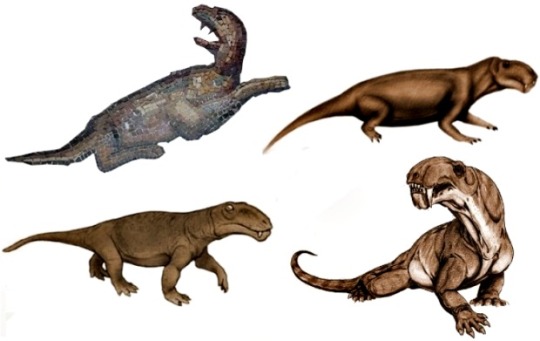
Esse mosaico é uma das primeiras representações romanas de cenas nilóticas, embora várias outras tenham sido descobertas em Pompeia. Como esses artistas poderiam retratar todos esses animais extintos antes da paleontologia? A resposta óbvia é que eles testemunharam esses animais e que eles eram comuns em sua vida cotidiana.
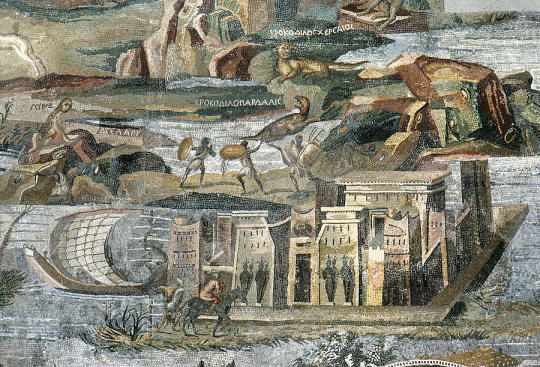
Detalhes sobre o Mosaico do Nilo de Palestrina
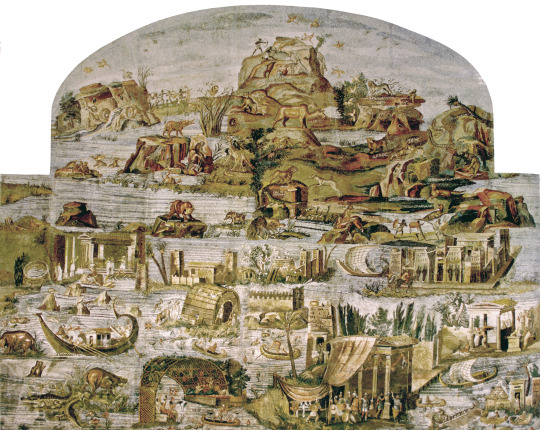
O Mosaico do Nilo de Palestrina é uma obra de arte em azulejo considerada uma obra-prima da antiguidade que fazia parte de uma gruta-santuário clássica em Palestrina, uma cidade a leste da Roma Antiga, na Itália central. Tem uma largura de 5,85 metros e uma altura de 4,31 metros e oferece um vislumbre do fascínio romano pelo exotismo egípcio antigo no século I a.C., tanto como uma manifestação inicial do papel do Egito no imaginário romano, quanto como um exemplo do gênero "paisagem nilótica", com uma longa história iconográfica no Egito e no mar Egeu .
O mosaico, com uma moldura em arco que identifica sua localização original como piso de uma abside em uma gruta, apresenta representações detalhadas de de gregos ptolomaicos e etíopes negros em cenas de caça a vários animais, incluindo animais pensados como extintos há 10.000 anos durante a Era do Gelo. Cada animal não só é representado com incrível precisão, como muitos são também nomeados.
É a mais antiga representação romana de cenas nilóticas, das quais várias outras foram descobertas em Pompéia. Um consenso sobre a datação da obra está surgindo lentamente. Paul G. P. Meyboom, professor assistente de Arqueologia Clássica na Universidade de Leiden, autor do livro The Nile Mosaic of Palestrina: Early Evidence of Egyptian Religion in Italy (Religions in the Graeco-Roman World) [Leiden, Brill, 1995], sugere uma data pouco antes do reinado de Sula (por volta de 100 a.C.) e trata o mosaico como uma evidência inicial da disseminação de cultos egípcios na Itália, onde Ísis foi sincretizada com Fortuna. Ele acredita que as cenas nilóticas foram introduzidas em Roma por Demétrio, o Topógrafo, um artista grego do Egito ptolomaico ativo (por volta de 165 a.C.). Claire Préaux (1904-1979), historiadora e filóloga belga especializada no período helenístico e professora na Université Libre de Bruxelles, enfatiza a natureza "escapista" do cenário fantástico.
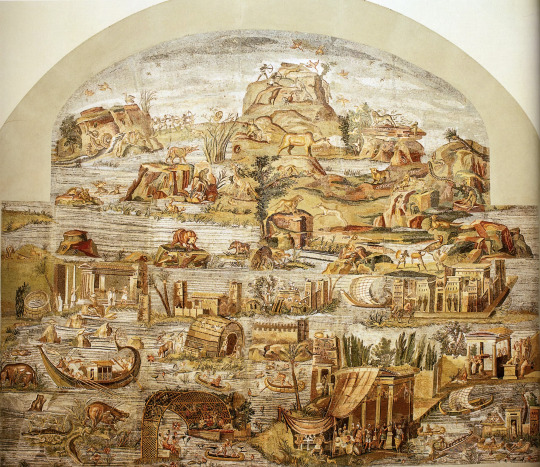
O Mosaico do Nilo ainda era visto na cidade italiana de Palestrina, antiga Praeneste, no século XV. Quando notados pela primeira vez pouco antes de 1507 por Antonio Volsco, um humanista do círculo de Pomponio Leto, os mosaicos ainda estavam in situ entre os vestígios do santuário de Fortuna Primigenia de Sula. Naquela época, a cidade era propriedade da família Colonna de Roma, cujo palazzo em Palestrina ocupava uma parte das ruínas.
No século XVII, Palestrina passou para a família Barberini, que entre 1624 e 1626 removeu a maior parte do mosaico de seu cenário, sem registrar a composição geral, e após novos movimentos e danos, o colocou em exposição no Palazzo Barberini em Palestrina, onde permanece. O mosaico foi restaurado e reparado em várias ocasiões, mas as aquarelas cuidadosas das seções foram feitas para Cassiano dal Pozzo antes da restauração inicial no opificio (do latim opificium, local de trabalho-fábrica) de São Pedro. A redescoberta de Helen Whitehouse das aquarelas há muito perdidas permitiu uma reconstrução dos segmentos sobreviventes de uma maneira mais significativa, embora muito permaneça incerto sobre a composição original. O mosaico tem sido uma das principais atrações do Museo Nazionale Prenestino no Palazzo Barberini em Palestrina desde 1953.
No mosaico, o Nilo serpenteia por vinhetas representando paisagens e assentamentos exóticos; os detalhes mais recônditos são cuidadosamente rotulados em grego, ressaltando a fonte alexandrina do gênero. Lembremos que o Nilo não é apenas um rio do Egito. O Nilo é o rio mais longo do mundo, estendendo-se para o norte por aproximadamente 4.000 milhas (ou 6.400 quilômetros) da África Oriental ao Mediterrâneo. Além do Egito, flui pelos países africanos do Sudão, Burundi, Ruanda, República Democrática do Congo, Tanzânia, Quênia, Uganda e Etiópia.
A arte nilótica como o mosaico do Nilo do primeiro século de Palestrina detalhou a vida ao longo do Nilo. A natureza precisa da relação entre o mosaico e as práticas cartográficas é controversa. Recentemente, o mosaico de Palestrina foi interpretado como um mapa topográfico real do Nilo: a parte superior do mosaico representa a Etiópia, a zona superior da seção inferior representa o Egito e o primeiro plano representa o Delta, de cima para baixo entendido como sul para norte, a convenção padrão para mapas antigos. Mais provavelmente, no entanto, o mosaico fornece uma grande e coerente composição da paisagem do Nilo durante a estação das cheias, embora dependente de convenções topográficas.
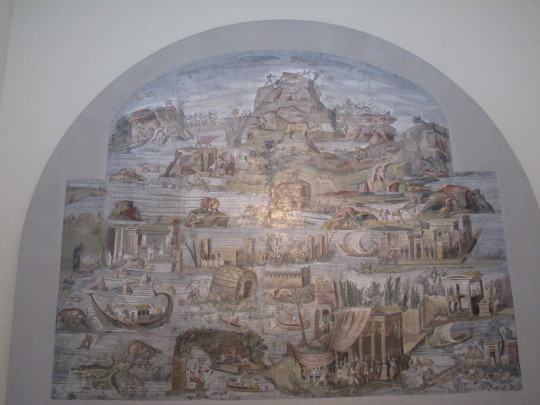
#palestrina#mosaic#romeitaly#roma antica#dinossauros#palentology#arqueologia#história#evolução#rivernile#egito#caçadores#caçada#obradearte#antiguidade
7 notes
·
View notes
Text

A krokotta from the Palestrina Nile mosaic (detail).
27 notes
·
View notes
Photo

Nile Mosaic, from Palestrina, Praeneste, 2nd century B.C.
The Nile Mosaic, located in the floor of a building near the Sanctuary of Fortuna Primigenia in Praeneste, is considered one of the most impressive mosaics recovered from Roman history. The mosaic is composed of tiny tesserae, which are teeth-shaped stones. The mosaic uses atmospheric perspective, a technique in which the items closest to the viewer are sharper and brighter, and the images at the back of the mosaic have fuzzier edges and duller color. This technique creates an effect of distance and depth. The mosaic depicts the Romans’ perception of Egyptian life on the Nile River and shows several Nile scenes. The closest images are of temples and civilian life, while the back images show wild animals and native Africans. Many of the animals present in the scene are made up, and inscriptions under their images are nonsense words. The clear exaggeration and inaccuracy in the mosaic shows the Romans’ limited knowledge of and fascination with Egypt and Egyptian life.
67 notes
·
View notes
Text
The Imposing Complex of Buildings of Praeneste/Palestrina's Forum Reopens to Visitors.
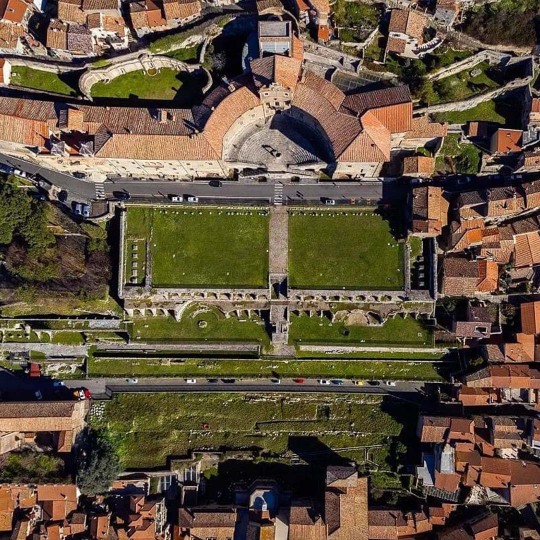
Not far from Rome, you can discover a unique place permeated by the history and culture of our territory: the National Archaeological Museum of Palestrina, the Sanctuary of Fortuna Primigenia, and the imposing Complex Buildings of the Forum of Praeneste/Palestrina reopened to visitors.
The Sanctuary of Fortuna Primigenia is the most remarkable example of Hellenistic architecture in Italy. Nowadays, its architecture shows up like an encounter between centuries of construction. Yet, here we have an irreplaceable testimony of its glorious remains in a structure made up of a series of artificial terraces interconnected by ramps.

The archaeological area is dominated by the austere Renaissance Palazzo Barberini, which stands on top of the ancient sanctuary and houses the National Archaeological Museum of Palestrina. In the rooms of the Museum, spread over three floors, the most important finds from ancient Praeneste and its territory are exhibited, arranged by significant themes that encompass the main aspects of the history, culture, and artistic productions of one of the central and thriving cities of ancient Lazio. Here the renowned mosaic of the Nile stands out among the largest and most famous Hellenistic mosaics that come to us in an excellent state of preservation.

A must-see.
From Thursday, 1st December, give yourself time to go on an exceptional ideal journey in the ancient city of Palestrina, retracing the ancients' stages towards the Sanctuary.
The Museum and the archaeological areas of Palestrina brought together in a single site, will provide an exceptional archaeological itinerary through distant space and time inside the ancient city.
And throughout December, you can come in for free.
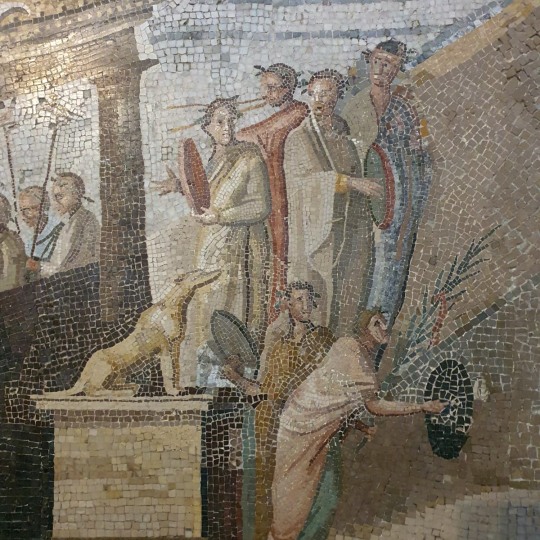
📍 Museo Archeologico Nazionale di Palestrina MANP, Piazza della Cortina, 00036 Palestrina (RM).
🕒 Museum: every day from 9:00 am to 9:00 pm 🕒 Archaeological area: times vary according to the season.
The complex is managed by ⏩ Lazio Regional Museums Directorate
Check out all the locations of ⏩ Lazio Regional Museums
Images courtesy of Museo Archeologico Nazionale di Palestrina MANP
youtube
More you might like ⏩ The Board Behind
#Museo Archeologico Nazionale di Palestrina MANP#the board behind#Palestrina#hellenistic period#hellenism#roman mosaics#ancient mosaic#mosaic#ancient art#ancient rome#ancient history#archaeology#Goddess of Fortune#Praeneste#colleferro#Youtube
1 note
·
View note
Text
The Seven Secrets About Silhouette Sunset Painting Only A Handful Of People Know | silhouette sunset painting
Art has existed for tens of bags of years. Given its continued and abiding history, it is alone accustomed that it would see bouncing trends. Time and time again, artists about the apple accept alternate to age-old models, with the cosmos authoritative after-effects in abounding of art history’s best important movements.

Catalyst Art Studio. Connecticut. Dog Cat Silhoue .. | silhouette sunset painting
Like added prevailing practices—including still-life painting and portraiture—maritime art dates aback to age-old times. A abyssal access to the appropriately constant mural genre, this blazon of art is authentic by a focus on the sea. Whether emphasizing the ocean’s accustomed beauty, exploring abyssal customs, or a mix of both, seascapes can asperse admirers in addition world, authoritative them one of art’s best approved treasures.
Rock paintings in Gobustan State Reserve, Azerbaijan (Photo: Wikimedia Commons Public Domain)

Custom Sunset with Silhouette Painting, Couples Portrait, Family .. | silhouette sunset painting
The age-old accepted assignment of amphibian art can be begin in Azerbaijan’s Gobustan National Park. Already amid at the shores of the since-expanded Caspian Sea, this assets boasts countless archaeological monuments, including a world-famous accumulating of over 6,000 bedrock carvings.
Created by age-old hunter-gatherers amid 5,000-20,000 BCE, these inscribed designs affection a ambit of accountable matter, including weapon-wielding warriors, angelic bodies, and age-old reed boats, which were argosy fabricated from grass-like plants that abound in wetlands.

Skyline Silhouette at Sunset Acrylic Canvas Painting – silhouette sunset painting | silhouette sunset painting
In Age-old Greece, artisans focused beneath on accustomed activity and added on mythology. Still, references to the sea are present in folklore-focused art, like The Siren Vase, a red-figured stamnos (a liquid-storing container) from the 5th aeon BCE.
This allotment of ceramics depicts one of Greek mythology’s best acclaimed scenes: back Odysseus, the “wreathed and bearded” advocate of Homer’s The Odyssey, has his aggregation bind him to the mast of his address so he can abide the adorable songs of the adorable sirens.

Sunset and Silhouette Painting – Palette and Pub – silhouette sunset painting | silhouette sunset painting
“Nile Mosaic of Palestrina,” ca. 100 BCE (Photo: Wikimedia Commons Public Domain)
The ocean is not the alone anatomy of baptize featured in Classical amphibian art. In 100 BCE, age-old Roman artisans crafted the Palestrina Mosaic, a pieced-together assuming of Egypt’s Nile River. This admirable delineation is amid the best-preserved and better actual mosaics from the Age-old Roman Empire.

Free Traceables – Step By Step Painting – silhouette sunset painting | silhouette sunset painting
Featuring an angled silhouette, it acceptable originally adorned a grotto—a bedrock alcove that artlessly or artificially appearance water—making its amphibian accent decidedly pertinent.
“Seafarers” Detail of the Bayeux Tapestry, 11th aeon (

Sunset Antelope Painting Abstract Tree Art Happy Calming Mood – silhouette sunset painting | silhouette sunset painting
The Seven Secrets About Silhouette Sunset Painting Only A Handful Of People Know | silhouette sunset painting – silhouette sunset painting | Welcome in order to our blog, in this particular period I am going to show you regarding keyword. Now, this can be a initial photograph:

21+ Beautiful Sunset Paintings | Free & Premium Templates – silhouette sunset painting | silhouette sunset painting
Why don’t you consider image previously mentioned? will be that remarkable???. if you’re more dedicated and so, I’l m teach you some impression yet again down below:
So, if you would like acquire all of these magnificent shots regarding (The Seven Secrets About Silhouette Sunset Painting Only A Handful Of People Know | silhouette sunset painting), click save link to store these shots for your laptop. These are all set for obtain, if you’d prefer and wish to own it, simply click save symbol on the web page, and it’ll be immediately saved to your notebook computer.} At last if you need to get unique and latest picture related with (The Seven Secrets About Silhouette Sunset Painting Only A Handful Of People Know | silhouette sunset painting), please follow us on google plus or bookmark the site, we try our best to offer you regular update with all new and fresh pictures. We do hope you enjoy staying right here. For many updates and latest information about (The Seven Secrets About Silhouette Sunset Painting Only A Handful Of People Know | silhouette sunset painting) graphics, please kindly follow us on tweets, path, Instagram and google plus, or you mark this page on book mark area, We attempt to give you update regularly with all new and fresh shots, like your searching, and find the right for you.
Here you are at our site, articleabove (The Seven Secrets About Silhouette Sunset Painting Only A Handful Of People Know | silhouette sunset painting) published . Today we are excited to announce that we have found a veryinteresting topicto be discussed, namely (The Seven Secrets About Silhouette Sunset Painting Only A Handful Of People Know | silhouette sunset painting) Many people attempting to find details about(The Seven Secrets About Silhouette Sunset Painting Only A Handful Of People Know | silhouette sunset painting) and certainly one of these is you, is not it?

Girl Silhouette Sunset Painting Girl’s Bedroom Art, Sunset Wall Decor, Silhouette Painting, Whimsical Wall Art, Original Art Work – silhouette sunset painting | silhouette sunset painting

Monochromatic silhouette | Art (Landscapes and Cityscapes .. | silhouette sunset painting

Autumn Tree Silhouette Sunset Acrylic Painting Art Print by emilyhunterhigging – silhouette sunset painting | silhouette sunset painting

Sunset Silhouette Painting by Lucy Deane – silhouette sunset painting | silhouette sunset painting

How To Paint A Sunset In Acrylics – Hot Air Balloon .. | silhouette sunset painting

Sky Clouds Sunset Grass Silhouette Digital Stock Illustration .. | silhouette sunset painting

Silhouette girl holding paint brush in the sunset. Concept big. | silhouette sunset painting
The post The Seven Secrets About Silhouette Sunset Painting Only A Handful Of People Know | silhouette sunset painting appeared first on Wallpaper Painting.
from Wallpaper Painting https://www.bleumultimedia.com/the-seven-secrets-about-silhouette-sunset-painting-only-a-handful-of-people-know-silhouette-sunset-painting/
0 notes
Text
16 Ugly Truth About Famous Impressionist Paintings | Famous Impressionist Paintings
Art has existed for tens of bags of years. Given its continued and abiding history, it is alone accustomed that it would see bouncing trends. Time and time again, artists about the apple accept alternate to age-old models, with the cosmos authoritative after-effects in abounding of art history’s best important movements.

Famous Paintings Reproduction Van Gogh Starry Night Over The Rhone Post-Impressionist Fine Art Canvas Print For Living Room Wall Decor – famous impressionist paintings | famous impressionist paintings
Like added prevailing practices—including still-life painting and portraiture—maritime art dates aback to age-old times. A abyssal access to the appropriately constant mural genre, this blazon of art is authentic by a focus on the sea. Whether emphasizing the ocean’s accustomed beauty, exploring abyssal customs, or a mix of both, seascapes can asperse admirers in addition world, authoritative them one of art’s best approved treasures.
Rock paintings in Gobustan State Reserve, Azerbaijan (Photo: Wikimedia Commons Public Domain)

Amazon.com: liwendi Cypress Tree in The Wheat Field Canvas Art .. | famous impressionist paintings
The age-old accepted assignment of amphibian art can be begin in Azerbaijan’s Gobustan National Park. Already amid at the shores of the since-expanded Caspian Sea, this assets boasts countless archaeological monuments, including a world-famous accumulating of over 6,000 bedrock carvings.
Created by age-old hunter-gatherers amid 5,000-20,000 BCE, these inscribed designs affection a ambit of accountable matter, including weapon-wielding warriors, angelic bodies, and age-old reed boats, which were argosy fabricated from grass-like plants that abound in wetlands.

top 14 Impressionist Paintings | Monet, Cezanne, Renir and Manet – famous impressionist paintings | famous impressionist paintings
In Age-old Greece, artisans focused beneath on accustomed activity and added on mythology. Still, references to the sea are present in folklore-focused art, like The Siren Vase, a red-figured stamnos (a liquid-storing container) from the 5th aeon BCE.
This allotment of ceramics depicts one of Greek mythology’s best acclaimed scenes: back Odysseus, the “wreathed and bearded” advocate of Homer’s The Odyssey, has his aggregation bind him to the mast of his address so he can abide the adorable songs of the adorable sirens.

The Four Most Famous Impressionist Paintings – Wales Venice Biennale – famous impressionist paintings | famous impressionist paintings
“Nile Mosaic of Palestrina,” ca. 100 BCE (Photo: Wikimedia Commons Public Domain)
The ocean is not the alone anatomy of baptize featured in Classical amphibian art. In 100 BCE, age-old Roman artisans crafted the Palestrina Mosaic, a pieced-together assuming of Egypt’s Nile River. This admirable delineation is amid the best-preserved and better actual mosaics from the Age-old Roman Empire.

Pachi And Her Favorite Art Famous Impressionist Paintings | The .. | famous impressionist paintings
Featuring an angled silhouette, it acceptable originally adorned a grotto—a bedrock alcove that artlessly or artificially appearance water—making its amphibian accent decidedly pertinent.
“Seafarers” Detail of the Bayeux Tapestry, 11th aeon (

top 14 Impressionist Paintings | Monet, Cezanne, Renir and Manet – famous impressionist paintings | famous impressionist paintings
16 Ugly Truth About Famous Impressionist Paintings | Famous Impressionist Paintings – famous impressionist paintings | Delightful to be able to my weblog, with this period I’ll explain to you with regards to keyword. And from now on, this is the initial impression:

Do You Know Some of the Famous Impressionist Flashcards Flashcards .. | famous impressionist paintings
How about graphic above? is actually that will wonderful???. if you believe thus, I’l m demonstrate a few image all over again underneath:
So, if you like to get these magnificent images related to (16 Ugly Truth About Famous Impressionist Paintings | Famous Impressionist Paintings), click on save button to download these images to your pc. They are all set for obtain, if you want and wish to get it, just click save badge on the web page, and it will be directly saved to your desktop computer.} At last if you desire to obtain new and the latest image related to (16 Ugly Truth About Famous Impressionist Paintings | Famous Impressionist Paintings), please follow us on google plus or bookmark this website, we try our best to present you daily up grade with fresh and new pictures. Hope you love staying right here. For some up-dates and latest news about (16 Ugly Truth About Famous Impressionist Paintings | Famous Impressionist Paintings) images, please kindly follow us on twitter, path, Instagram and google plus, or you mark this page on bookmark area, We attempt to present you up grade periodically with all new and fresh pictures, love your surfing, and find the right for you.
Thanks for visiting our site, articleabove (16 Ugly Truth About Famous Impressionist Paintings | Famous Impressionist Paintings) published . Nowadays we’re delighted to declare that we have found an incrediblyinteresting contentto be reviewed, that is (16 Ugly Truth About Famous Impressionist Paintings | Famous Impressionist Paintings) Lots of people trying to find info about(16 Ugly Truth About Famous Impressionist Paintings | Famous Impressionist Paintings) and certainly one of these is you, is not it?
What are some of the most famous impressionist paintings? – Quora – famous impressionist paintings | famous impressionist paintings

Monet’s Water Lilies Poster Famous Impressionist Painting Water Lilies and Japanese Bridge Fine Art Canvas Print Wall Art For Living Room Home Decor – famous impressionist paintings | famous impressionist paintings

14 Impressionist paintings – the Impressionism seen through 14 works – famous impressionist paintings | famous impressionist paintings

Impression, Sunrise by Claude Monet | Monet, Ideias para pintura .. | famous impressionist paintings

14 Famous Impressionist Artists and Their Masterpieces – Parblo – famous impressionist paintings | famous impressionist paintings

Pin on Impressionist paintings – famous impressionist paintings | famous impressionist paintings
What are some of the most famous impressionist paintings? – Quora – famous impressionist paintings | famous impressionist paintings

History’s 14 Greatest Impressionist Painters | Virtu-Art | famous impressionist paintings

14 Most Famous Impressionist Paintings | Learnodo Newtonic – famous impressionist paintings | famous impressionist paintings
The post 16 Ugly Truth About Famous Impressionist Paintings | Famous Impressionist Paintings appeared first on Painter Legend.
Painter Legend https://www.painterlegend.com/wp-content/uploads/2020/05/famous-paintings-reproduction-van-gogh-starry-night-over-the-rhone-post-impressionist-fine-art-canvas-print-for-living-room-wall-decor-famous-impressionist-paintings.jpg
0 notes
Photo
This image is from the Anne Walshe Bestiary
Pliny distinguishes between the Crocotta and Leucrocotta. He referred to the crocotta,
When crossed with [the hyena,] the Ethiopian lioness gives birth to the corocotta, that mimics the voices of men and cattle in a similar way. It has an unbroken ridge of bone in each jaw, forming a continuous tooth without any gum.
He says of the leucrocotta,
the swiftest of all beasts, about the size of an ass, with a stag's haunches, a lion's neck, tail and breast, badger's head, cloven hoof, mouth opening right back to the ears, and ridges of bone in place of rows of teeth—this animal is reported to imitate the voices of human beings.
the description of the mouth opening ear to ear matches the above illustration. This matches the illustration of the leucrote found in the Rochester Bestiary as well:

Other sources differentiate these two beasts as well.
The Crocotta is a lion/hyena hyprid, according to the Aberdeen Bestiary:
In a part of Ethiopia the hyena mates with the lioness; their union produces a monster, named crocote. Like the hyena, it too produces men's voices. It never tries to change the direction of its glance but strives to see without changing it. It has no gums in its mouth. Its single, continuous tooth is closed naturally like a casket so that it is never blunted.
The same manuscript says of the Leucrota (several pages later)
Of the leucrota The beast called leucrota comes from India. It is the swiftest of all wild animals. It is as big as an ass, with the hindquarters of a deer, the chest and legs of a lion, the head [ms cuts off]

One ancient illustration that is clearly labeled as the Crocotta is found in the Nile Mosaic currently in the possession of the Museo Archeologico Nazionale di Palestrina. This image much more closely resembles the spotted hyena than any of the above illustrations.

Wikipedia combines these two mythical creatures, but the historical sources suggest that in ancient and medieval times, they were differentiated in marked ways, in both morphology (as seen above) and in geography (the crocotta from Ethiopia, the leucrota from India).

Cryptid of the Day: Crocotta
Description: A horse sized canine of Indian and Ethiopian mythology, the Crocotta legend was first brought to the west by Greek philosopher Strabo, then later by Roman historian Pliny. Pliny described the creature as hyena like, could give birth without the need of a mate, and can even impersonate the vocals of a human.
121 notes
·
View notes
Text
Reading Helen in Egypt - in Egypt
Reading Helen in Egypt – in Egypt
Reading HD’s Helen in Egyptwhile in Egypt is a special treat. Of course, how I got here is not nearly as fascinating as how Helen got here. Helen’s first trip to Egypt ended up taking more than a few lifetimes. And not just any lifetimes. In chronological order, it took the lifetimes of Stesichorus, Herodotus, Euripides, and Dio Chrysostom–a stretch of 745 years (630 BCE – 115 CE!)–to document…
View On WordPress
0 notes